Reply To:
Name - Reply Comment
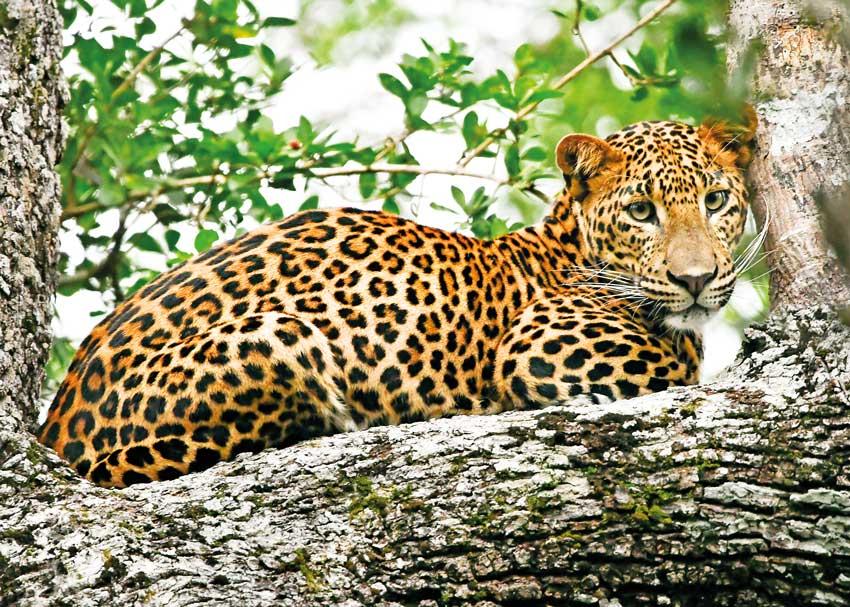
PIC courtesy Sampath Bandara
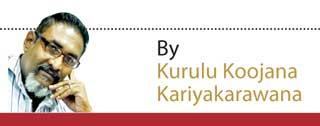 Wilpattu National Park is the largest protected area for wildlife in Sri Lanka. Spanning across Puttalam and Anuradhapura districts whilst bordering Mannar and Vavuniya districts, the park owns a territory of 131, 656 hectares, also being the only place with a high possibility of encountering the ‘Big 3’; the elephant, the leopard and the sloth bear.
Wilpattu National Park is the largest protected area for wildlife in Sri Lanka. Spanning across Puttalam and Anuradhapura districts whilst bordering Mannar and Vavuniya districts, the park owns a territory of 131, 656 hectares, also being the only place with a high possibility of encountering the ‘Big 3’; the elephant, the leopard and the sloth bear.
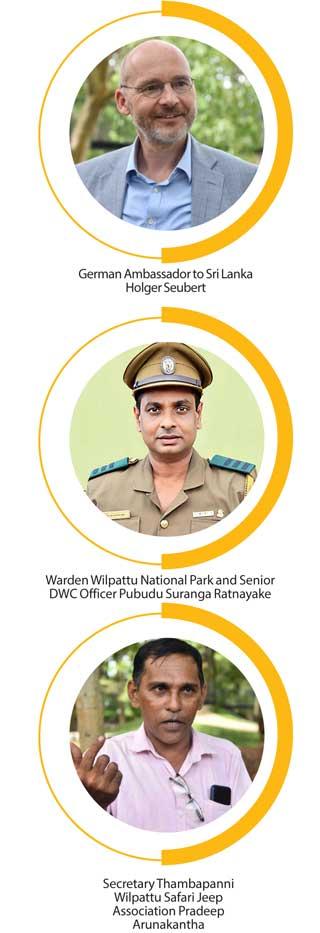 Declared a national park in 1938 with a global recognition of Ramsar Wetland of International Importance since 2013, the park was closed for two decades over the civil conflict. Yet, this national treasure shows potential to be further developed as a top wildlife game park in the South Asian region, if due recognition is given at a national level.
Declared a national park in 1938 with a global recognition of Ramsar Wetland of International Importance since 2013, the park was closed for two decades over the civil conflict. Yet, this national treasure shows potential to be further developed as a top wildlife game park in the South Asian region, if due recognition is given at a national level.
The WNP gained wide publicity in the media recently when a German Government funded project to enhance the infrastructure development within the park was unveiled by the German Ambassador to Sri Lanka Holger Seubert. The German Technical Corporation (GIZ) through its Federal Ministry of Economic Cooperation and Development (BMZ Germany) handed over several completed projects to the Department of Wildlife Conservation (DWC) at an estimated cost of Euros 8 million.
These projects included fully-fledged beat offices for the DWC crew at the 30th mile post and Pomparippu, a resting area with sanitary facilities for the visiting tourists at Kumbukwila, a cluster campsite at Kala Oya and a state-of- the-art hanging bridge over the Kala Oya at the Kumbukgahawala Entrance of Eluwankulama in Puttalam.
German Ambassador at the unveiling ceremony of the hanging bridge at Eluwankulama said that he is proud to have been able to assist in developing this top game park and emphasized on how important it is for a country to have its national parks in good condition, to attract scores of local and foreign tourists, in terms of making much needed foreign exchange for Sri Lanka during these trying times.
It was noteworthy how the senior management of the DWC, the park administration as well as the industry stakeholders, like the safari jeep drivers and hoteliers who were present at this occasion were overwhelmed with gratitude for this friendly gesture by a European nation, at a time when local authorities had numerous opportunities to develop the park.
Before the difficult times started in early 2020 with a global pandemic restricting tourism for almost two years, followed by the economic downturn experienced by the Sri Lankans with fuel and food shortages, the Wilpattu National Park used to earn about Rs. 10 million in revenue per month from its ticket sales from 5,000 to 10,000 visiting local and foreign tourists.
Speaking about the current situation Pradeep Arunakantha, Secretary of Thambapanni Wilpattu Safari Jeep Association said there were 15 jeep drivers operating from the Eluwankulama Entrance in Puttalam, who were making their living through safari tours prior to the pandemic and the economic crisis. However, this figure has dropped in half to seven jeeps at present and he is hopeful that with the installment of the new hanging bridge, the park would attract more and more visitors even during the rainy season.
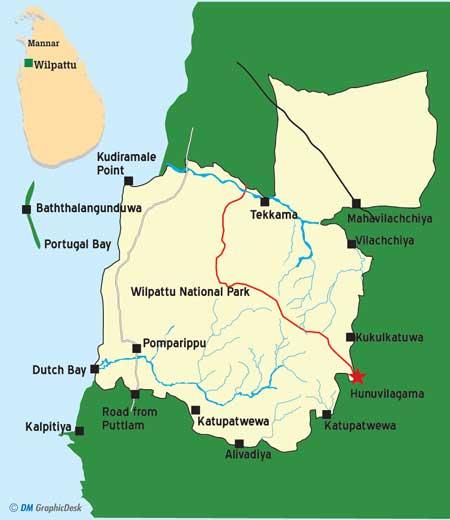 Arunakantha, who is also the Principal of Wijayapura Vidyalaya in Vanathawilluwa drives his safari jeep as a part time venture after school hours and during school holidays. According to him one of the major obstacles that prevailed forever was the difficulty in crossing the Kala Oya causeway for the visitors to enter the park from the Eluwankulama entrance in Puttalam during the rainy seasons.
Arunakantha, who is also the Principal of Wijayapura Vidyalaya in Vanathawilluwa drives his safari jeep as a part time venture after school hours and during school holidays. According to him one of the major obstacles that prevailed forever was the difficulty in crossing the Kala Oya causeway for the visitors to enter the park from the Eluwankulama entrance in Puttalam during the rainy seasons.
At the WNP the wet season is experienced during the periods from September to December and March to May and when the torrential rains lead to flash floods, it is impossible to cross the Kala Oya through the old ‘sapaththu palama’ (shoe bridge). But with the new hanging bridge a concrete solution has been received to this problem, was Arunakantha’s opinion.
One of the other reasons that have led the safari jeep drivers to give up their trade was the high maintenance costs of their vehicles. Arunakantha directly put the blame on the interior safari routes of the park, which the roads are in a dilapidated condition.
“Most of the roads within the park had been developed in the past many years except for a 7 kilometre stretch on the old Mannar road, of which the condition is very hostile for the vehicles. We have made numerous requests and complaints to the DWC to repair this stretch for the sake of our jeeps, as every week there will be a repair required. This cost is becoming unbearable for us to sustain with the skyrocketing prices of the spare parts and not to mention the expenses we have to bear on ever fluctuating fuel prices,” he said.
Arunakantha said that a regular jeep driver would charge about Rs. 12,000 from a group of seven persons for a trip of half day within the WNP and up to Rs. 24,000 for a full day’s experience to travel between the stretch of 52 kilometres from the park’s main entrance of Hunuvilagama in Anuradhapura and Eluwankulama entrance in Puttalam.
“We make a serious request to all three ministries of Wildlife and Forest Conservation, Highways and Tourism to look into this plight and develop the roads within the park to enable us to carry out our duties smooth and to render a better and comfortable service to the visiting tourists,” Arunakantha said.
Although any private four wheel drive vehicle is allowed inside the park, strict guidelines have to be followed and such private vehicles are allowed only if the groups are accompanied with a licensed tour guide. The code of conduct for the tourists include observing wildlife in silence, not feeding the animals and not getting off the vehicles outside designated areas, etc.
Issues the jeep drivers -- important stakeholder of the safari park industry -- have faced is miniscule compared to the perennial problems the park itself and its caretakers of the DWC had been facing for the past many years.
The key issues are ranging from lack of budgetary allocations for the park management and operations, staff shortages, boundary disputes with the residents of the surrounding villagers and the never ending human elephant conflict.
Explaining further, Warden of the Wilpattu National Park and Senior DWC Officer Pubudu Suranga Ratnayake told the Daily Mirror the park was making a monthly income of Rs. 10 million from its ticket sales before the Covid and fuel crisis began. The fuel issue, which crippled the general travelling practices, had been hampered by the ‘Galle Face Aragalaya’ that started in April restricting more and more tourists from visiting or touring Sri Lanka, the Warden opined.
“In February and March last year the WNP have earned Rs. 9.8 million and Rs. 9.6 million respectively from our ticket sales, which lead to a drastic decline from April onwards, until the last couple of months of 2022. A ticket for a local tourist is sold at Rs. 150, whilst a foreigner is charged USD 25.
Moreover, the fuel crisis had a heavy impact not only on the WNP but all the other national parks countrywide. From tourist vehicles to safari jeeps and then to the service vehicles used by the DWC and our security patrolling vehicles were affected without sufficient fuel stocks. Most of our routine operations had to be curtailed whilst the circuit bungalows and dormitories within the park had to be shutdown as no gas and kerosene were available.
The interior establishments of the WNP are run through generators on fuel as no electricity supply from the main grid is available. There are seven circuit bungalows and a dormitory within the park to be occupied by the eager travellers. The bungalows are located in Talawila, Pannikawila, Lunuwewa, Menikwila, Manawila, Mahawewa and Kokmote, whilst the dormitory is situated at Maradanmaduwa. These are in good condition and if there are solar panels for these establishments that would be an added benefit during a fuel crisis. Also, there are several campsites available for more independent visitors,” Ratnayake explained.
Wilpattu National Park has five entrances from its Northern, Eastern and Southern boundaries, out of which two are with ticketing counters for the visitors. Hunuvilagama of Anuradhapura on the South Eastern border being the main entrance and also locates the WNP Headquarters. The second entrance cum ticketing counter is located on the Southern boundary at Eluwankulama in Puttalam. The other three entrances located on the Northern boundaries of the park respectively at Mollikulama towards Mannar, Mahavilachchiya and Thanthirimale are not opened for the general public. Out of this Mollikulama and Thanthirimale entrances do not function at present even for the purposes of the DWC officials.
“One of the main problems we have to deal with at present is the shortage of staff to carry out our day-to-day operations. The WNP has five zones. One is the tourism zone, where the visitors are allowed and the other four zones are protected zones dedicated for animal breeding grounds and no outsiders are permitted to enter or trespass. There are five Range Stations in the park at Thanthirimale, Vilachchiya, Mollikulama, Kala Oya and Eluwankulama. Also, six Beat Stations are there in Kukulkatuwa, Aliwadiya, Katupathwewa, Pomparippu, Marawila and Tekkama.
At the moment we have only a cadre of about 80 DWC staff members and we are in dire need of another 25 to 30 members to maintain routine duties. All the mentioned Range Stations, Beat Stations, public and restricted entrances have to be manned by these staff. Meanwhile the armed staff is required to perform the daily duties of security patrolling in and around the park and its vulnerable locations where illegal poaching and deforestation is suspected to take place,” Warden Ratnayake said.
“Presently, the two Beat Stations at Marawila and Tekkama are shutdown due to the lack of staff and those interior points towards the Northern border of the park are considered to be two essentially vulnerable points that have to be manned round the clock. We have informed the staff problem to the senior DWC officials including the Regional Assistant Director and Deputy Director Visitor Service Management and Eco Tourism Chandani Wilson.
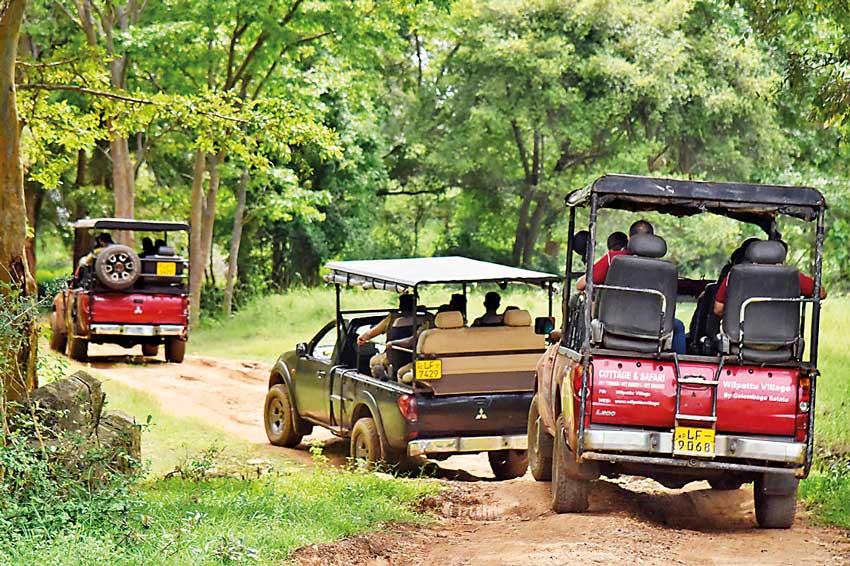
The problem persists as there had hardly been any recruitments lately as the appropriate persons seldom apply for the Forest Ranger or Beat Officer positions. Unlike other armed forces in the country people with liking for nature and wildlife should be absorbed to the DWC and to maintain game parks,” he said.
The DWC staff ranges from Voluntary Guide, Civil Assistant, Wildlife Guide, Ranger Assistant, Ranger (categories III, II, I) Assistant Director and Deputy Director. Out of these ranks the WNP severely lacks staff for the position of Wildlife Guard. According to the Warden, another serious issue is the park’s boundary disputes with the surrounding villages, especially near the Hunuvilagama main entrance and Vilachchiya. The boundary disputes at the Hunuvilagama main entrance and at Vilachchiya were initiated as a part of a political campaign in late 2022. The Warden believes immediate action must be taken to secure its boundaries to reach the optimum potential as a national park.
“From the boundary of the park there is a one mile radius of a buffer zone called Development Restricted Zone. This buffer zone has been set up to safeguard the animals that may stray outside the forest boundary and have encounters with the humans of the surrounding villages. Although, some of the areas in the buffer zones belong to the residents it is strictly prohibited to initiate any constructions apart from farming. But sometimes people excavate huge agri-wells without a safety wall and elephants and other large animals have fallen into these on numerous instances. Sometimes it is very difficult to deal with the local authorities like divisional secretaries and Grama Seva officials when these boundary disputes surface. Certain groups try to exert pressure on us with the political influence. Wilpattu is the largest national park in the country and so much more attention could be given to this preserve this national treasure,” was the Warden’s opinion.
PIX BY SAMANTHA PERERA
|
|
|